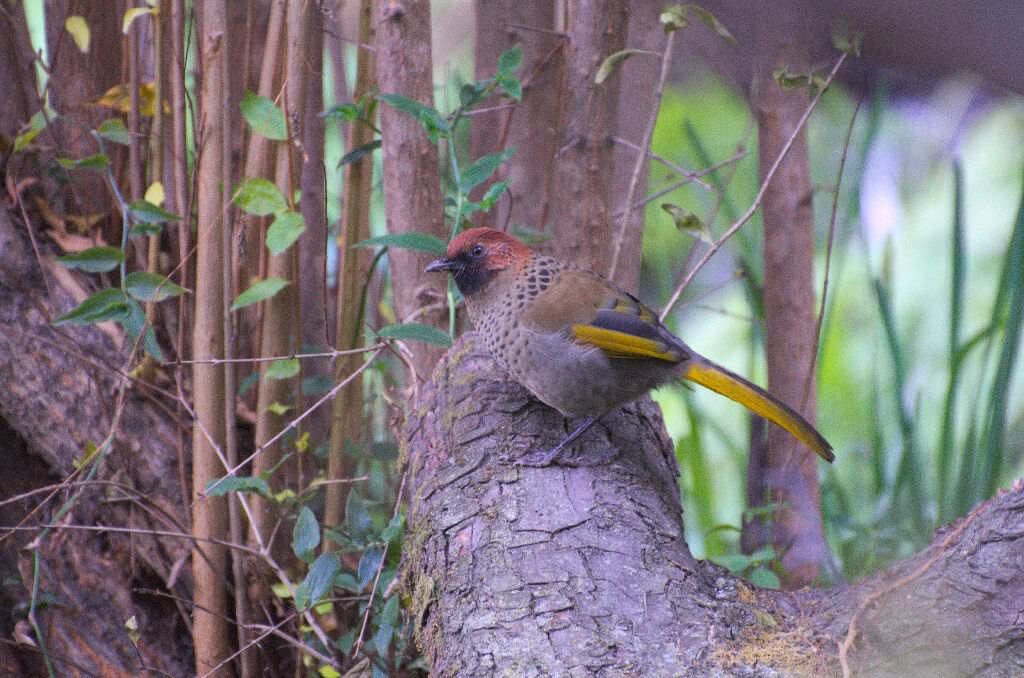
Garrulax erythrocephalus (Chestnut crowned laughingthrush)
Garrulax erythrocephalus, commonly known as the Chestnut-crowned Laughingthrush, is a striking bird species observed within the Great Himalayan National Park (GHNP). Its rich chestnut-colored crown and loud, laughing calls make it both visually and audibly distinctive in the park’s mid- to high-altitude forests. Birdwatchers exploring the Tirthan and Sainj valleys often encounter this secretive species in the early morning or late afternoon when it is most active.
Habitat and Distribution
Within GHNP, the Chestnut-crowned Laughingthrush typically inhabits temperate broadleaf forests, including areas dense with rhododendron and oak. It prefers altitudes between 2,000 to 3,200 meters, especially in moss-laden, humid zones that provide ample foraging cover. The bird’s preference for thick undergrowth and bamboo patches often makes it challenging to spot, although its loud, melodious calls usually reveal its presence.
These birds are often found moving in noisy flocks, especially outside the breeding season, and may join mixed-species foraging parties.
Behavior and Diet
The Garrulax erythrocephalus is omnivorous, feeding on insects, berries, and small invertebrates. It forages mainly on or near the ground, using its strong feet to scratch through leaf litter. It also climbs into shrubs and low trees in search of berries and nectar.
Breeding usually occurs in the spring and early summer, with nests constructed close to the ground in thick vegetation. Both parents participate in feeding the chicks, demonstrating strong pair bonds.
Conservation Importance
While not globally threatened, the Chestnut-crowned Laughingthrush relies on undisturbed forest habitats, making GHNP’s protected environment essential to its long-term survival. Its presence indicates healthy, intact forest systems. Continued conservation efforts in GHNP help safeguard this and other vulnerable bird species from habitat degradation.
Habitat and Distribution
Within GHNP, the Chestnut-crowned Laughingthrush typically inhabits temperate broadleaf forests, including areas dense with rhododendron and oak. It prefers altitudes between 2,000 to 3,200 meters, especially in moss-laden, humid zones that provide ample foraging cover. The bird’s preference for thick undergrowth and bamboo patches often makes it challenging to spot, although its loud, melodious calls usually reveal its presence.
These birds are often found moving in noisy flocks, especially outside the breeding season, and may join mixed-species foraging parties.
Behavior and Diet
The Garrulax erythrocephalus is omnivorous, feeding on insects, berries, and small invertebrates. It forages mainly on or near the ground, using its strong feet to scratch through leaf litter. It also climbs into shrubs and low trees in search of berries and nectar.
Breeding usually occurs in the spring and early summer, with nests constructed close to the ground in thick vegetation. Both parents participate in feeding the chicks, demonstrating strong pair bonds.
| Common name | Chestnut- crowned Laughingthrush |
| Scientific name | Garrulax erythrocephalus |
| Family | Garrulacinae |
| Description | Chestnut on head, dark scaling/ spotting on mantle and breast, olive-yellow wings, and olive-yellow tail sides. Undergrowth in forest and bushes in cultivation. Resident and winter migrant. Found at an altitudinal range 1800-3400m and migrant in winter up to 1200m. |
Conservation Importance
While not globally threatened, the Chestnut-crowned Laughingthrush relies on undisturbed forest habitats, making GHNP’s protected environment essential to its long-term survival. Its presence indicates healthy, intact forest systems. Continued conservation efforts in GHNP help safeguard this and other vulnerable bird species from habitat degradation.



